Effects of Near-Infrared Pulsed Light on the Attention of Human Beings Using Electroencephalography
Abstract
1. Introduction
2. Materials and Methods
2.1. Participants
2.2. PBM Stimulator
2.3. Procedure
2.4. Control
2.5. EEG Recording and Measurement
2.6. Attention Test
3. Results
3.1. EEG Results
3.2. Attention Test Results
4. Discussion
4.1. Light Stimulation and EEG
4.2. EEG and Attention
4.3. Methods to Improve Attention
4.4. Limitations and Future Directions
5. Conclusions
Author Contributions
Funding
Institutional Review Board Statement
Informed Consent Statement
Data Availability Statement
Conflicts of Interest
References
- Graham, F.K.; Hackley, S.A. Passive and active attention to input. In Handbook of Cognitive Psychophysiology: Central and Autonomic Nervous System Approaches; Wiley: Hoboken, NJ, USA, 1991; pp. 251–356. [Google Scholar]
- Marshall, P.; Hoelzle, J.; Nikolas, M. Diagnosing Attention-Deficit/Hyperactivity Disorder (ADHD) in young adults: A qualitative review of the utility of assessment measures and recommendations for improving the diagnostic process. Clin. Neuropsychol. 2021, 35, 165–198. [Google Scholar] [CrossRef] [PubMed]
- Olfers, K.J.F.; Band, G.P.H. Game-based training of flexibility and attention improves task-switch performance: Near and far transfer of cognitive training in an EEG study. Psychol. Res. 2018, 82, 186–202. [Google Scholar] [CrossRef]
- Yoshida, K.; Takeda, K.; Kasai, T.; Makinae, S.; Murakami, Y.; Hasegawa, A.; Sakai, S. Focused attention meditation training modifies neural activity and attention: Longitudinal EEG data in non-meditators. Soc. Cogn. Affect. Neurosci. 2020, 15, 215–224. [Google Scholar] [CrossRef] [PubMed]
- Jiang, Y.; Abiri, R.; Zhao, X. Tuning Up the Old Brain with New Tricks: Attention Training via Neurofeedback. Front. Aging Neurosci. 2017, 9, 52. [Google Scholar] [CrossRef] [PubMed]
- Knowles, M.M.; Wells, A. Single Dose of the Attention Training Technique Increases Resting Alpha and Beta-Oscillations in Frontoparietal Brain Networks: A Randomized Controlled Comparison. Front. Psychol. 2018, 9, 1768. [Google Scholar] [CrossRef]
- Newson, J.J.; Thiagarajan, T.C. EEG Frequency Bands in Psychiatric Disorders: A Review of Resting State Studies. Front. Hum. Neurosci. 2019, 12, 521. [Google Scholar] [CrossRef]
- Salansky, N.; Fedotchev, A.; Bondar, A. Responses of the nervous system to low frequency stimulation and EEG rhythms: Clinical implications. Neurosci. Biobehav. Rev. 1998, 22, 395–409. [Google Scholar] [CrossRef]
- Chen, A.C.N.; Liu, F.J.; Wang, L.; Arendt-Nielsen, L. Mode and site of acupuncture modulation in the human brain: 3D (124-ch) EEG power spectrum mapping and source imaging. NeuroImage 2006, 29, 1080–1091. [Google Scholar] [CrossRef]
- Teplan, M.; Krakovská, A.; Stolc, S. Direct effects of audio-visual stimulation on EEG. Comput. Methods Programs Biomed. 2011, 102, 17–24. [Google Scholar] [CrossRef]
- Lyskov, E.B.; Juutilainen, J.; Jousmäki, V.; Partanen, J.; Medvedev, S.; Hänninen, O. Effects of 45-Hz magnetic fields on the functional state of the human brain. Bioelectromagnetics 1993, 14, 87–95. [Google Scholar] [CrossRef]
- Davis, L. The Alpha Plan: Making the Most of Your Mind; Methuen: London, UK, 1986; p. 26. [Google Scholar]
- Wu, J.H.; Chang, W.D.; Hsieh, C.W.; Jiang, J.A.; Fang, W.; Shan, Y.C.; Chang, Y.C. Effect of low level laser stimulation on EEG. Evid. Based Complement. Altern. Med. 2012, 2012, 951272. [Google Scholar] [CrossRef] [PubMed]
- Wu, J.H.; Chang, Y.C. Effect of low-level laser stimulation on EEG power in normal subjects with closed eyes. Evid. Based Complement. Altern. Med. 2013, 2013, 476565. [Google Scholar] [CrossRef] [PubMed]
- Sohlberg, M.M.; Mateer, C.A. Effectiveness of an attention-training program. J. Clin. Exp. Neuropsychol. 1987, 9, 117–130. [Google Scholar] [CrossRef]
- Stroop, J.R. Studies of interference in serial verbal reactions. J. Exp. Psychol. 1935, 18, 643–662. [Google Scholar] [CrossRef]
- Tsai, S.R.; Hamblin, M.R. Biological effects and medical applications of infrared radiation. J. Photochem. Photobiol. B Biol. 2017, 170, 197–207. [Google Scholar] [CrossRef]
- Hsieh, C.W.; Wu, J.H.; Hsieh, C.H.; Wang, Q.F.; Chen, J.H. Different brain network activations induced by modulation and nonmodulation laser acupuncture. Evid. Based Complement. Altern. Med. 2011, 2011, 951258. [Google Scholar] [CrossRef]
- Sakamoto, H.; Inouye, T.; Shinosaki, K. Preservation of alpha rhythm shortly after photic driving. Int. J. Neurosci. 1993, 73, 227–233. [Google Scholar] [CrossRef]
- Milone, F.F.; Minelli, A.T.; Cian, R. Alpha rhythms response to 10 Hz flicker is wavelength dependent. Neurosci. Med. 2013, 4, 94–100. [Google Scholar] [CrossRef]
- Shan, Y.C.; Fang, W.; Chang, Y.C.; Chang, W.D.; Wu, J.H. Effect of near-infrared pulsed light on the human brain using electroencephalography. Evid. Based Complement. Altern. Med. 2021, 2021, 6693916. [Google Scholar] [CrossRef]
- Pfurtscheller, G.; Aranibar, A. Event-related cortical desynchronization detected by power measurement of scalp EEG. Electroencephalogr. Clin. Neurophysiol. 1977, 42, 817–826. [Google Scholar] [CrossRef]
- Klimesch, W.; Doppelmayr, M.; Schimke, H.; Ripper, B. Theta synchronization in a memory task. Psychophysiology 1997, 34, 169–176. [Google Scholar] [CrossRef]
- da Silva, F.L. The rhythmic slow activity (theta) of the limbic cortex: An oscillation in search of a function. In Induced Rhythms in the Brain; Birkhäuser: Boston, MA, USA, 1992; pp. 83–102. [Google Scholar]
- Klimesch, W.; Doppelmayr, M.; Russegger, H.; Pachinger, T. Theta band power in the human scalp EEG and the encoding of new information. NeuroReport 1996, 7, 1235–1240. [Google Scholar] [CrossRef] [PubMed]
- Klimesch, W.; Doppelmayr, M.; Russegger, H.; Pachinger, T.; Schwaiger, J. Induced alpha band power changes in the human EEG and attention. Neurosci. Lett. 1998, 244, 73–76. [Google Scholar] [CrossRef] [PubMed]
- Klimesch, W. EEG alpha and theta oscillations reflect cognitive and memory performance: A review and analysis. Brain Res. Rev. 1999, 29, 169–195. [Google Scholar] [CrossRef] [PubMed]
- Shereena, E.A.; Gupta, R.K.; Bennett, C.N.; Sagar, K.J.V.; Rajeswaran, J. EEG Neurofeedback Training in Children with Attention Deficit/Hyperactivity Disorder: A Cognitive and Behavioral Outcome Study. Clin. EEG Neurosci. 2018, 50, 242–255. [Google Scholar] [CrossRef]
- Shema-Shiratzky, S.; Brozgol, M.; Cornejo-Thumm, P.; Geva-Dayan, K.; Rotstein, M.; Leitner, Y.; Hausdorff, J.M.; Mirelman, A. Virtual reality training to enhance behavior and cognitive function among children with attention-deficit/hyperactivity disorder: Brief report. Dev. Neurorehabilit. 2018, 22, 431–436. [Google Scholar] [CrossRef]
- Lorenzo, G.; Gómez-Puerta, M.; Arráez-Vera, G.; Lorenzo-Lledó, A. Preliminary study of augmented reality as an instrument for improvement of social skills in children with autism spectrum disorder. J. Educ. Inf. Technol. 2019, 24, 181–204. [Google Scholar] [CrossRef]
- Barbaroux, M.; Dittinger, E.; Besson, M. Music training with Démos program positively influences cognitive functions in children from low socio-economic backgrounds. PLoS ONE 2019, 14, e0216874. [Google Scholar] [CrossRef]
- Lai, Y.J.; Chang, K.M. Improvement of attention in elementary school students through fixation focus training activity. Int. J. Environ. Res. Public Health 2020, 17, 4780. [Google Scholar] [CrossRef]
- Stancin, I.; Zeba, M.Z.; Friganovic, K.; Cifrek, M.; Jovic, A. Information on Drivers’ Sex Improves EEG-Based Drowsiness Detection Model. Appl. Sci. 2022, 12, 8146. [Google Scholar] [CrossRef]
- Shahbakhti, M.; Beiramvand, M.; Nasiri, E.; Chen, W.; Solé-Casals, J.; Wierzchon, M.; Broniec-Wójcik, A.; Augustyniak, P.; Marozas, V. The Importance of Gender Specification for Detection of Driver Fatigue using a Single EEG Channel. In Proceedings of the 2022 14th Biomedical Engineering International Conference (BMEiCON), Songkhla, Thailand, 10–13 November 2022. [Google Scholar] [CrossRef]
- Julio, R.C.; Aleksandra, B.K.; Francisco, G.L. Low-level light therapy improves cortical metabolic capacity and memory retention. J. Alzheimer’s Dis. 2012, 32, 741–752. [Google Scholar]
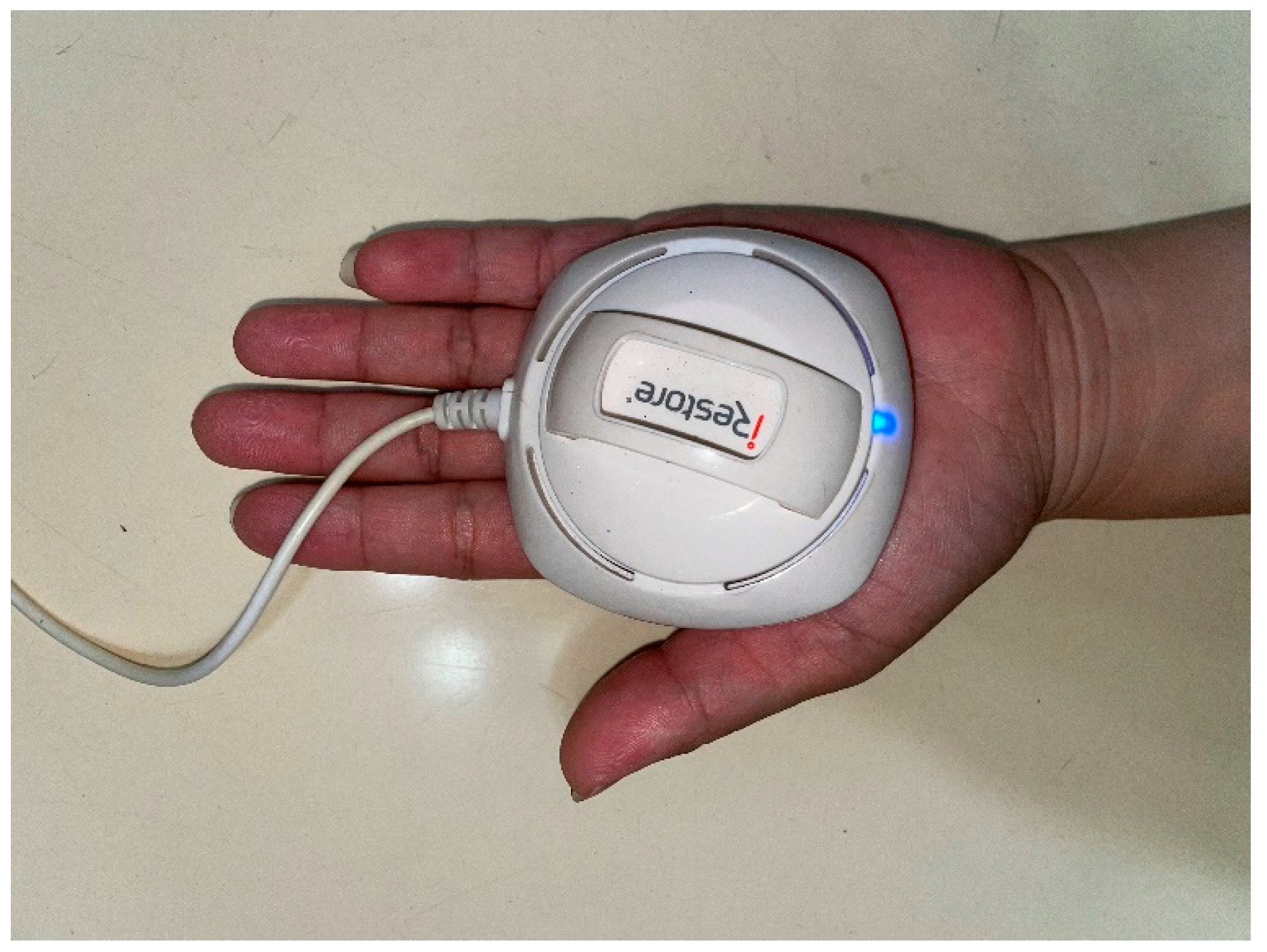

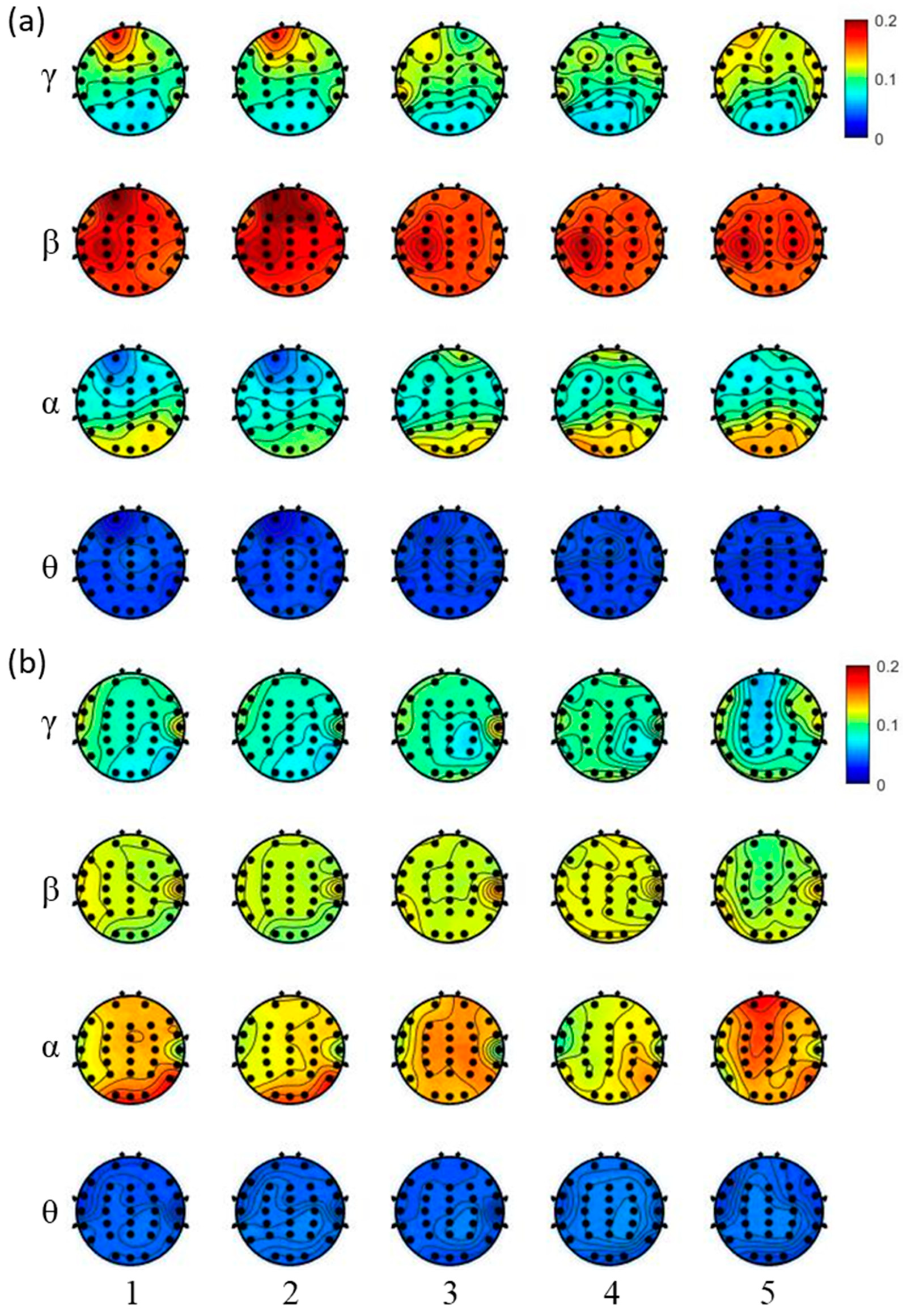

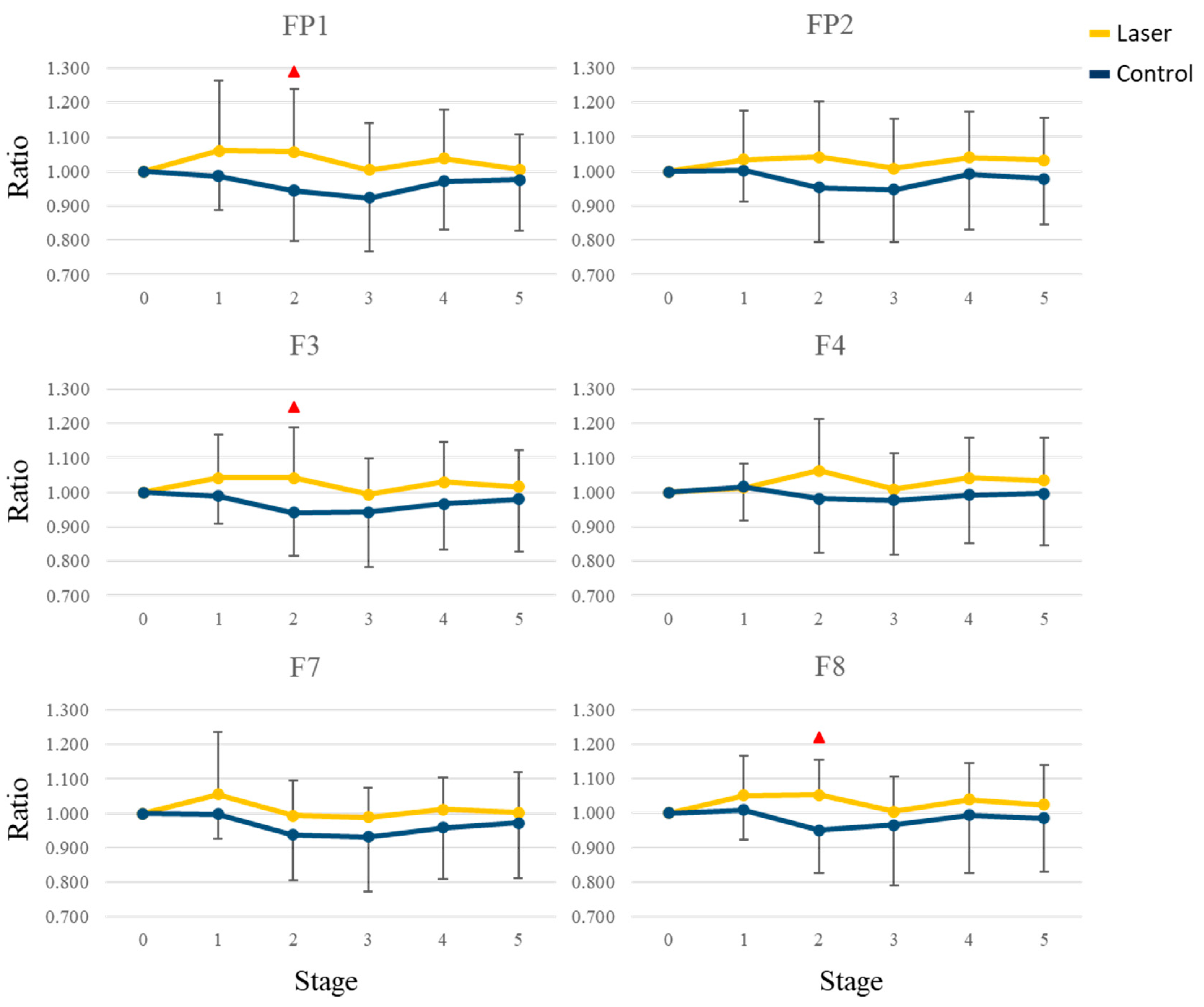
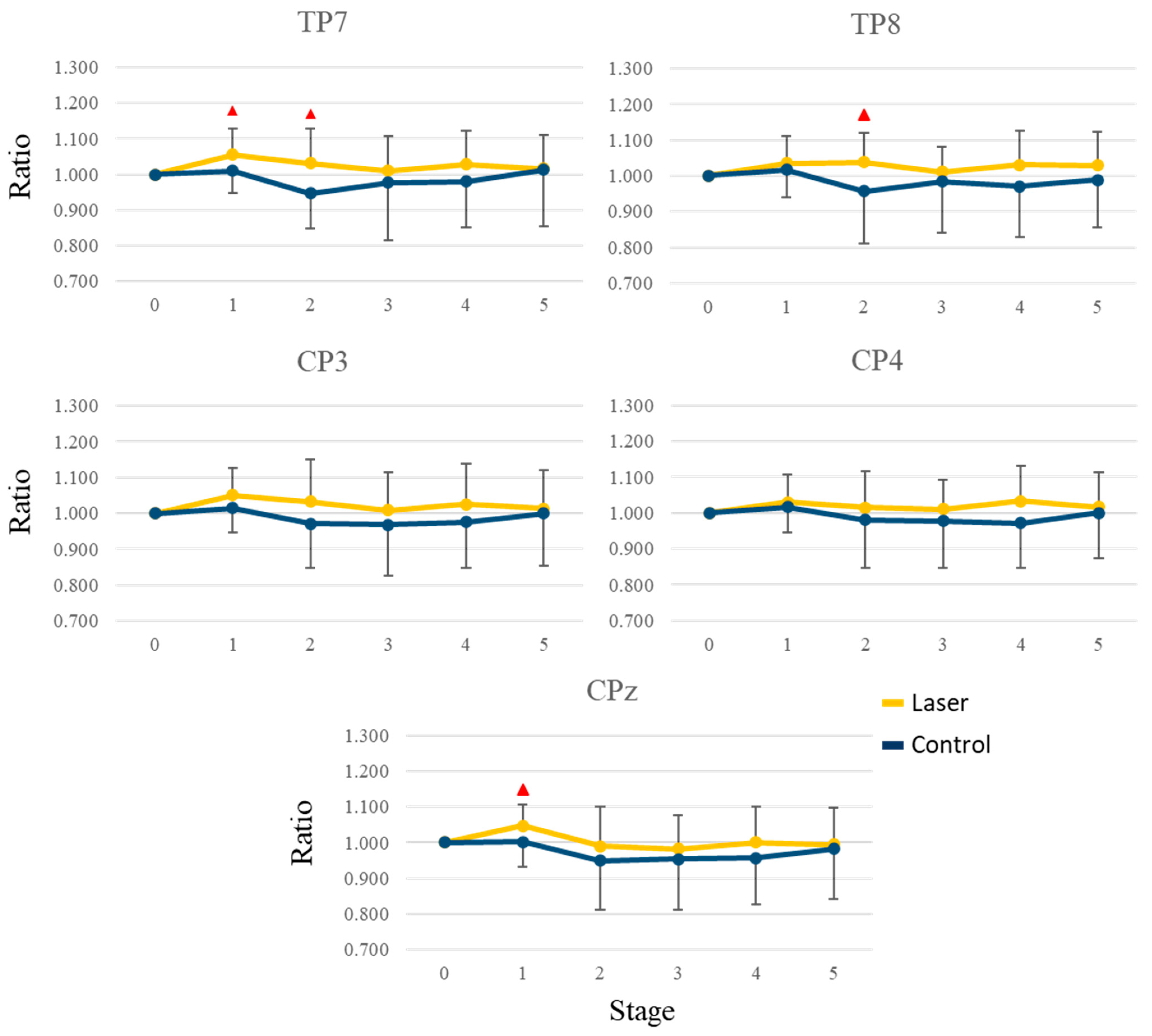

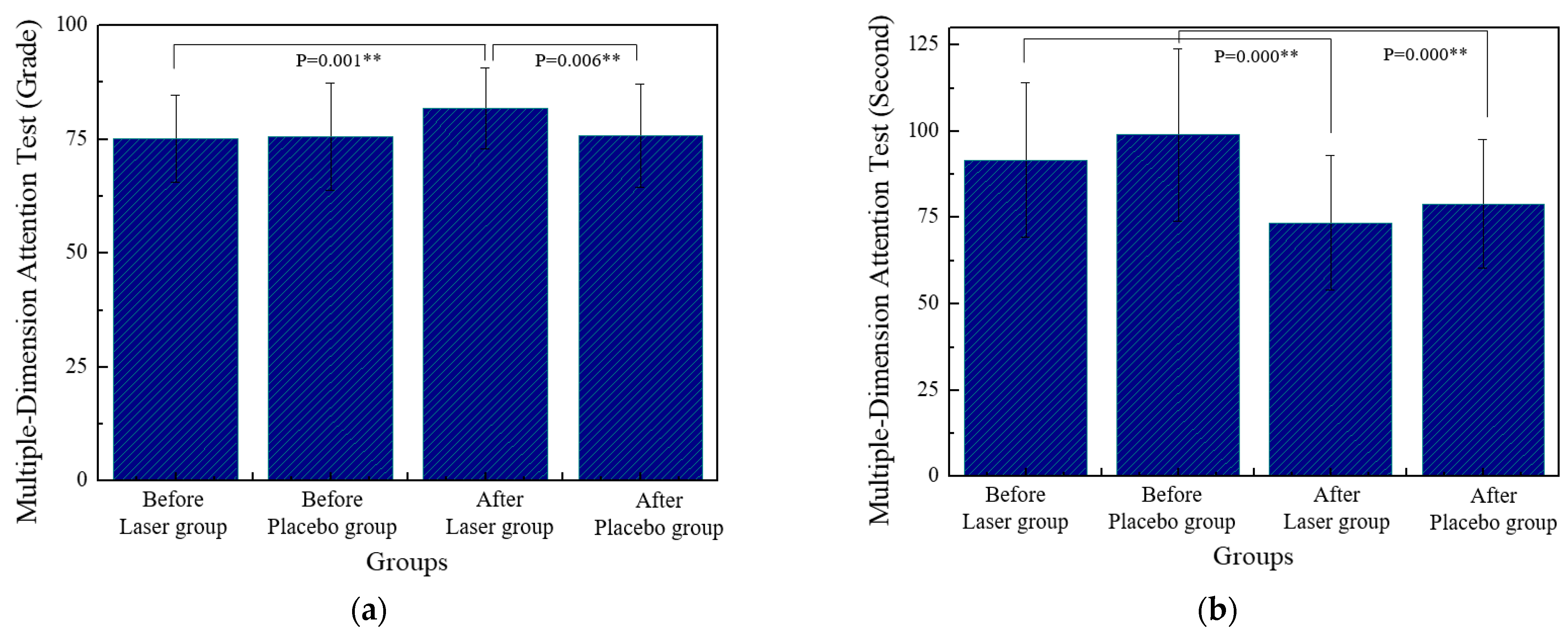
| Item | Experimental Group | Placebo Group |
|---|---|---|
| Subject number | 20 | 20 |
| Male/female | 12/8 | 12/8 |
| Age (years) | 21.35 ± 0.74 | 21.78 ± 1.16, p = 0.260 |
| Stimulator | Laser (30 mW) | LED (30 mW) [21] | Laser (7 mW) [13] | Laser (7 mW) [14] | |
|---|---|---|---|---|---|
| Task | Conducting 3 Tests (Open Eyes) | No Action (Open Eyes) | No Action (Open Eyes) | No Action (Closed Eyes) | |
| Brainwave | Beta | FT7, TP7 and CPz; FP1, F3, F8, FT7, FC3, FT8, T3, T4, TP7, TP8 and T5 increase ↑ | C4-P4 increase ↑ | T3-T5,T4-T6, F7-T3, F8-T4 decrease ↓ | P3, O1, P4, O2 decrease ↓ |
| Alpha | None variation | C3-P3, C4-P4, P3-O1, P4-O2, T3-T5, T4-T6 more increase ↑↑ | C3-P3, C4-P4, P3-O1, P4-O2, T3-T5, T4-T6 increase more increase ↑↑ | P3, O1, P4, O2 F3, F4, C3, C4 more decrease ↓↓ | |
| Theta | None variation | P4-O2, T4-T6, T3-T5 increase ↑ | P3-O1, P4-O2, T4-T6increase ↑ | None variation | |
| Delta | None variation | None variation | None variation | None variation | |
Disclaimer/Publisher’s Note: The statements, opinions and data contained in all publications are solely those of the individual author(s) and contributor(s) and not of MDPI and/or the editor(s). MDPI and/or the editor(s) disclaim responsibility for any injury to people or property resulting from any ideas, methods, instructions or products referred to in the content. |
© 2023 by the authors. Licensee MDPI, Basel, Switzerland. This article is an open access article distributed under the terms and conditions of the Creative Commons Attribution (CC BY) license (https://creativecommons.org/licenses/by/4.0/).
Share and Cite
Wu, J.-H.; Yang, C.-Y.; Chang, Y.-C.; Shan, Y.-C. Effects of Near-Infrared Pulsed Light on the Attention of Human Beings Using Electroencephalography. Life 2023, 13, 1490. https://doi.org/10.3390/life13071490
Wu J-H, Yang C-Y, Chang Y-C, Shan Y-C. Effects of Near-Infrared Pulsed Light on the Attention of Human Beings Using Electroencephalography. Life. 2023; 13(7):1490. https://doi.org/10.3390/life13071490
Chicago/Turabian StyleWu, Jih-Huah, Chia-Yen Yang, Yang-Chyuan Chang, and Yi-Chia Shan. 2023. "Effects of Near-Infrared Pulsed Light on the Attention of Human Beings Using Electroencephalography" Life 13, no. 7: 1490. https://doi.org/10.3390/life13071490
APA StyleWu, J.-H., Yang, C.-Y., Chang, Y.-C., & Shan, Y.-C. (2023). Effects of Near-Infrared Pulsed Light on the Attention of Human Beings Using Electroencephalography. Life, 13(7), 1490. https://doi.org/10.3390/life13071490







